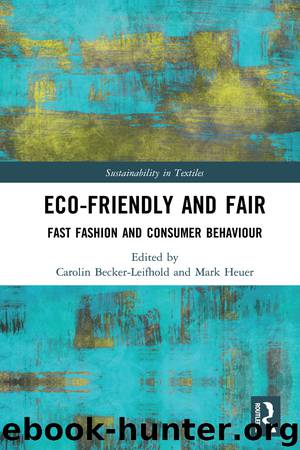Eco-Friendly and Fair by Carolin Becker-Leifhold & Mark Heuer

Author:Carolin Becker-Leifhold & Mark Heuer [Carolin Becker-Leifhold]
Language: eng
Format: epub
Publisher: Routledge
Published: 2018-05-10T16:00:00+00:00
5. Conclusion
The Die Kleiderei und the Kleiderkammer are two socially and ecologically important institutional models of urban collective use, albeit differently situated historically. They make consumption possible beyond retail stores and therefore the prices set by the industry and trade. Collective use is a form of the continual use of clothes. It is however only one of many possibilities through which clothing can be consumed in a more sustainable way. Chris Gibson and Elyse Stoffe list all in all six areas of practice: first, the consumption of high-quality textiles, second the recycling of items of clothing, third the continued use of clothing, fourth the choice of classical cuts and colours, fifth repair, and sixth care through use such as careful washing (Gibson & Stanes, 2011, p. 176f). In the age of fast fashion, consumers thus have here leeway to extend the life cycle of their clothes and to discover themselves a more sustainable approach to clothing. If the price and therefore the value of clothing continues to fall, the small revolutions that projects such as the Kleiderkammer or Die Kleiderei accomplish each day will come even more to the fore.
I have delineated three cultural preconditions for the work of Die Kleiderei and the Kleiderkammer. First – at least in the social group that donates used clothing – an excess of material and clothing must exist. Second, the fact that after private use, clothing is not treated by certain groups in society as trash, but rather as a resource that is put into further circulation. The success of eBay and flea markets has normalized the donating and purchasing of used clothing and opens possibilities for multiple other institutions based on selling, exchanging or donating. Nevertheless, there is still a need to differentiate between donating – such as giving and sharing – and collaborative consumption (Belk, 2015, p. 204). If I donate my used clothes to the Kleiderkammer, I give over my ownership. If I lend a friend a pullover, then we are sharing. If I make a monthly contribution to a car or amount of clothing with other people, then that can be termed collaborative consumption. The responsibility and ownership lies not on me. If I borrow a dress for myself at a hiring outlet, I also purchase temporary and clearly defined user rights. These examples are instances of temporary access; a complete change of owner is only accessible at a used clothes store.
The third precondition to using clothing collectively lies in the way the transition is anonymously or personally organized. Clothing can be shared under specific social conditions determining its transfer (Podkalicka & Meese, 2012), such as via the system of donation and level of need or strong individual curators engaging with strangers. Collective use is however also based on the material premise that the items of clothing are of a high-enough quality for a long life span. It is known that particularly cheap clothes are more quickly discarded by consumers (Defra, 2008, p. ii) and the materials from which they are made cannot be recycled (Int.
Download
This site does not store any files on its server. We only index and link to content provided by other sites. Please contact the content providers to delete copyright contents if any and email us, we'll remove relevant links or contents immediately.
Tokyo Geek's Guide: Manga, Anime, Gaming, Cosplay, Toys, Idols & More - The Ultimate Guide to Japan's Otaku Culture by Simone Gianni(2346)
Batik by Rudolf Smend(2155)
Life of Elizabeth I by Alison Weir(2054)
The Little Book of Bettie by Tori Rodriguez & Dita von Teese(1644)
Vogue on: Dolce & Gabbana by Luke Leitch(1632)
Vogue on: Manolo Blahnik by Chloe Fox(1551)
Paris Undressed by Kathryn Kemp-Griffin(1466)
A Victorian Lady's Guide to Fashion and Beauty by Mimi Matthews(1383)
How to Dress by Alexandra Fullerton(1378)
Pretty Iconic by Sali Hughes(1332)
Indigo by Catherine E. McKinley(1269)
The Light of the World by Elizabeth Alexander(1244)
101 Things I Learned in Law School by Matthew Frederick(1199)
The Language of Fashion by Barthes Roland(1174)
Lazy Perfection by Jenny Patinkin(1164)
Fashion Victims by Alison Matthews David(1157)
Fashion Illustration 1920-1950 by Walter T. Foster(1147)
Architecture by Davis Amy(1144)
House of Versace: The Untold Story of Genius, Murder, and Survival by Ball Deborah(1138)
